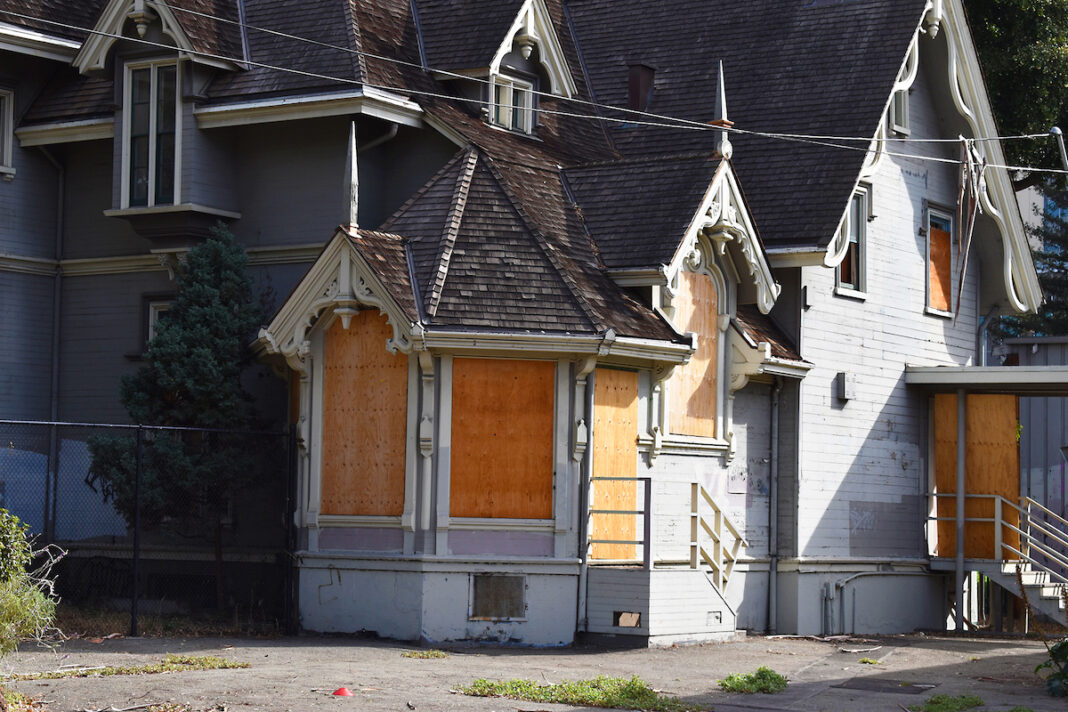For nearly 160 years, the Joseph Mora Moss House has survived in Mosswood Park, at what is now Broadway and MacArthur Boulevard in Oakland’s Temescal neighborhood. Built in 1864, while the Civil War was raging back East, it was described by the Historic American Buildings Survey in 1960 as “One of the finest if not the finest existing example of Gothic architecture—to be found in the East Bay, and possibly in Northern California.”
In 1975, it was listed as Oakland Historic Landmark #6, worthy of being preserved as a unique historic resource. Until recently, its survival was endangered by a combination of inaction by previous Oakland city administrations, and vandalism and recurring fires caused by some of the people residing in homeless encampments that have existed in the park for many years.
The future restoration and preservation of Mosswood Cottage, as it’s popularly called, was in conflict with the needs of these encampments, since efforts to relocate those unhoused citizens can’t be accomplished until there are enough shelter beds for them. A 2018 decision by the Ninth Circuit Court of Appeals, Martin vs. Boise, required cities and counties to find enough beds for everyone living in a homeless encampment before they can be relocated.
A possible solution for this conflict, as well as other steps that need to be taken to preserve Mosswood Cottage, is being actively discussed by a neighborhood group, Friends of Mosswood House, and Oakland’s current city administration. But major challenges remain in carrying out any resolution for preserving and restoring this historic landmark, so that it may become a valuable community and cultural resource.
From Moss to Park
Mosswood Cottage has an interesting history. Joseph Moss immigrated to San Francisco from Philadelphia in 1854 and became a successful businessperson, engaging in banking, public utility enterprises and an ice company. He also joined several civic organizations, including the California Academy of Sciences and the California School for the Deaf and Blind. In 1868, he became a member of the Board of Regents of the University of California.
Then in 1863, Moss purchased a 32-acre plot that was just north of the Oakland City limits. The next year, he hired architect R.S.H. Williams to complete the design of a “Gothic cottage” for his primary residence. This style was popular during the Victorian Era, having been inspired by the medieval novels of Sir Walter Scott from the early 1800s. The type of home he built was called a “cottage” in Victorian times, because it has one full story on the first floor, and a smaller second story.
The construction was completed late in 1864, at a cost of $14,500. The grounds were also carefully landscaped, with lush flower beds; pine, oak and eucalyptus trees; and expansive lawns, some of which were incorporated into what would later become Mosswood Park.
Mosswood Cottage has retained all of the original features that make it an outstanding example of Victorian Gothic Revival architecture. The two-story house sports a profusion of high-peaked gables, decorated with a variety of scalloped and snaking barge boards topped with steeple-like finials that create a Romantic image. Ornately carved original front doors remain, though they were damaged by a fire recently, and are now covered by a padlocked fake door.
In addition, the original Gothic pointed-arch latticed windows survive, and several have intricate stained glass patterns. Inside, the first floor has a library, study, parlor, kitchen and dining room, and the second floor has six bedrooms. The house was built with the finest materials, including sawn-wood oak floors, redwood wall paneling, and marble sink tops and fireplace mantels, most of which are still in place.
When Moss died in 1880, his widow inherited the property. And when she died childless in 1904, her heirs sold the remaining 11-acre site to a group of bankers at a public auction. In 1907, Oakland voters approved a bond measure to buy the plot and turn it into a city park. A wrought iron fence was then erected around the house to protect it from vandals. That fence was removed many years ago.
Mosswood has been owned by the City of Oakland’s park department since 1910, which was recently renamed the parks, recreation, and youth development department by Mayor Sheng Thao’s new administration. Until the 1990s, the house was used as a facility for civic activities including public meetings, lectures, and after-school activities and school field trips. It was then closed to the public and used as a storage unit for several years, and has been vacant and suffering the effects of deferred maintenance for decades.
This summer, the City of Oakland erected a seven-foot-tall chain-link fence around the house to protect it during the construction of a new recreation center, and from further vandalism (the old rec center was destroyed by arson in 2016). Funds were recently allocated by the current Oakland City administration to build the new recreation center next to the cottage. Funding will be allocated to restore the house once phase three of the new rec center construction is completed. Thus, it could be several years before restoration work begins on Mosswood Cottage.
According to Dana Riley, assistant director of the parks, recreation, and youth development department, “The city’s Community Homelessness Services Division will manage any relocation of those homeless residents that may be necessary to begin construction on this project,” which Riley stated was scheduled to begin before the end of this summer, though no firm date has been set.
Meanwhile, architectural and engineering studies are needed to cost out a realistic budget for stabilizing and fully restoring Mosswood Cottage. One preliminary engineering estimate called for the old brick foundation to be replaced first, which would drive up the total cost of a full restoration to an unrealistically high figure that would clearly be a non-starter for the cash-strapped City of Oakland to absorb.
The city’s current budget deficit is estimated to be $360 million over the next two years. However, historic landmarks are not required to have brick foundations replaced, only reinforced. Friends of Mosswood House is trying to arrange for a new, more realistic architectural study and restoration estimate, one that could bring the cost down to below $10 million.
Based on past uses of Mosswood Cottage by the City of Oakland, some future options for an adaptive reuse of the house might include having a local or regional nonprofit group take out a long-term lease on the house, so it could be repurposed as a performing or visual arts center, or perhaps some type of community resource facility. But given the uncertain future of the house, any specific proposed future use will have to await the completion of a realistic budget to take to the City of Oakland for a full restoration of this irreplaceable historic treasure.
Historic Wins
Oakland’s track record on restoring its most valuable historic buildings and creating adaptive reuses for them has been an encouraging one. The best-known example of such enlightened policy regarding the city’s historic sites is the Paramount Theater, on Broadway at 21st Street. Designed in 1931 by the famed Bay Area architect Timothy Pfleuger, this Art Deco masterpiece was the largest movie theater on the West Coast when it opened. It fell on hard times during the 1960s with the decline of attendance at large single-screen movie theaters. What followed was that it was closed during the early 1970s and sat empty, facing an uncertain future.
Then in 1972, the Oakland Symphony purchased the building for $1 million, with half of that amount donated by the theater group that owned it, and the other half from private donors. The entire building underwent a painstaking restoration in 1973, and reopened later that year.
For the past 50 years, the Paramount has been used as a multi-purpose performing and visual arts facility, and it has hosted: concerts of jazz, blues, R&B, rock, gospel and classical music; variety shows, comedy acts, live theater and the Oakland Ballet; and screenings of silent and classic Hollywood films. The building was placed on the National Register of Historic Places in 1973, and designated a California Historic Landmark in 1976.
Another restoration success story is the Fox Oakland Theater, located at 1815 Telegraph Ave. in Uptown Oakland. Designed by the prolific local firm of Weeks and Day in a mixture of Hindu and Islamic motifs, this was the first sound movie theater west of Chicago when it opened in 1928. The Fox suffered declining attendance in the early 1960s, and closed as a movie theater in 1965. Following a decade of occasional use as a venue for various events, the theater was in such disrepair that the city’s public works department actually suggested demolishing it and replacing it with a parking lot.
After sitting empty for decades, The Oakland Redevelopment Agency bought the Fox in 1996 for $3 million. A group of concerned citizens, Friends of the Oakland Fox, began preliminary restoration work, and then Mayor Jerry Brown proposed housing Oakland Charter School for the Arts in the building. The Friends and the city’s Redevelopment Agency eventually raised $75 million for a full restoration and adaptive reuse of the Fox. The theater reopened in 2009. Besides the charter school, the auditorium has been used for music concerts, stand-up comedy acts, lectures and political events.
Those citizens who are working diligently to restore Mosswood Cottage as an irreplaceable historic treasure and community resource can take inspiration from such examples of Oakland’s past successes in historic preservation.












Very nice piece. Thanks for writing it!
Thanks for the history lesson and encouraging future.